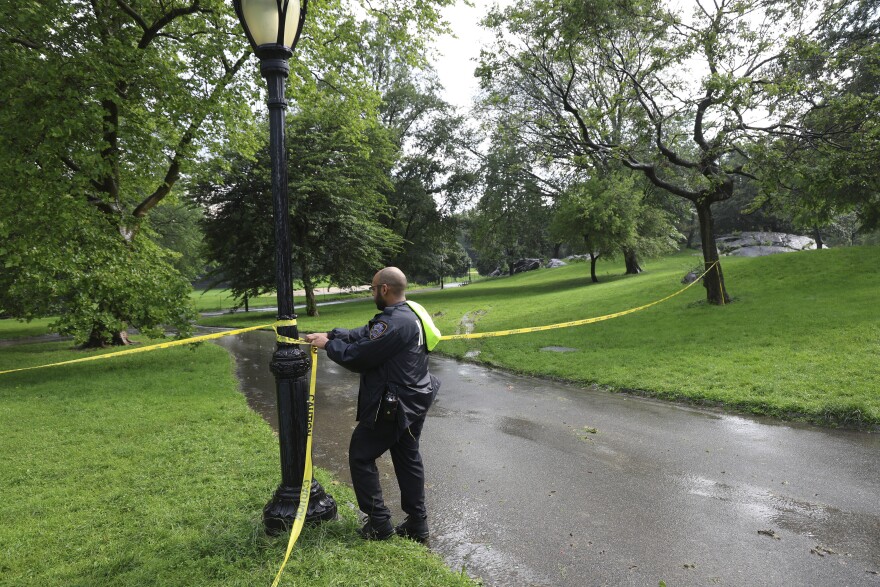MIAMI — In June, a 15-year-old was standing under a tree in Central Park in New York City when it was struck by lightning. The electrical current transferred from the tree to his chain necklace, giving him minor burns, but he survived.
The next day, a lightning strike killed a tourist as he stood in ankle-high water at a central Florida beach.
And just this month, lightning strikes killed a man who was playing golf in New Jersey, a man at an outdoor archery range also in New Jersey and Norwegian Olympic skier Audun Groenvold.
Lightning has killed about 20 people and injured many others across the country each year over the past decade, according to the National Weather Service. Florida, Oklahoma and Texas are among the states where the lightning strikes have been most concentrated, according to weather data firm Vaisala Xweather.
At least 12 people have been killed in the United States by lightning strikes this year, according to the weather service and the National Lightning Safety Council. Global warming also generates more favorable conditions for severe thunderstorms, which can bring heavy rains and cause extensive damage.
Here are tips from meteorologists and other weather experts on how to protect oneself during a thunderstorm.
Summer afternoons and evenings can bring more storms.
It’s important to be aware that thunderstorms occur most often during the summer months, in the late afternoons or evenings, weather experts said.
“Summer’s longer days allow for more heating, and a warmer environment can hold more moisture to fuel the storms,” said Ryan Phillips, a meteorologist for the Miami-Fort Lauderdale NBC station WTVJ-TV.
“In most instances in the United States, thunderstorms are fueled by the heating of the day,” he said. “Therefore, morning activities will help you beat the threat for storms with a lightning threat.”
Weather experts said if you will be outside during the summer, it is important to have the latest weather forecast and know the location of safe shelters in the event of a thunderstorm.
“Even with a low chance for thunderstorms to develop, staying aware is your first line of defense,” Phillips said.
If you can hear thunder, seek shelter.
Thunder is a sign that lightning will follow, and that is when people should move to a safe space immediately. Lightning can strike as far as 10 miles away from its parent thunderstorm, according to the weather service.
Phillips said a common misconception is that if the sun is out, even during a thunderstorm, there won’t be any lightning. But that is wrong.
“As a rule,” he said, “if you’re hearing thunder, it’s time to be inside.”
When there is a thunderstorm nearby, people should avoid open areas, tall objects and metal structures like fences and poles, which can act as lightning rods, according to the Florida Health Department.
The agency warned that people should “never take shelter under trees” because they can attract a strike and then act as conduits for electricity.
What if I’m on a boat during a storm?
A boat on water is especially vulnerable during a thunderstorm because lightning tends to strike the highest object in an area. The Oklahoma Department of Emergency Management recommends that boaters get to shore and into a building as soon as possible if there is a threat of a thunderstorm, and that they lower fishing poles and other tall objects.
If boaters can’t get to shore quickly, people should stay in a dry spot on the boat, the agency said on its website.
“Do not touch electrical or metal objects,” it added.
Even showers and sinks can conduct electricity.
The National Oceanic and Atmospheric Administration recommends that during a thunderstorm people stay inside a large, enclosed structure such as a school, shopping center, office building or private residence with plumbing and electrical wiring.
“If lightning strikes the building, the plumbing and wiring will conduct the electricity more efficiently than a human body,” the agency said.
Once inside, do not bathe, shower, wash dishes or have any other contact with water during a thunderstorm, because lightning can travel through a building’s plumbing, according to recommendations from the Centers for Disease Control and Prevention, which noted that people should also stay away from electronic equipment as well as windows, doors and porches.
If there are no buildings available, an enclosed vehicle such as a car, van or school bus would make a good alternative.
When can you go back outside? Listen for the last sound of thunder, and then stay inside for an additional 30 minutes, the Texas Department of Insurance advises on its website.
Apps now offer lightning warnings.
Various weather apps offer alerts that notify users when lightning has been detected near them, and remind users of safety tips.
These apps include MyRadar, the Weather Channel’s Storm Radar and Carrot Weather. Some have fees at premium levels.
The RadarScope app shows lightning strike locations within the last 30 minutes.
Another app called Tomorrow.io has a “Lightning Countdown” feature that tracks the time since the last nearby strike and then resets with each new hit.
This article originally appeared in The New York Times. © 2025 The New York Times





